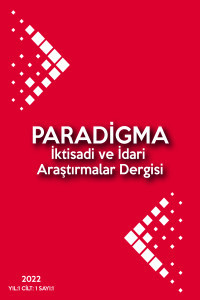CDS PRİMLERİ İLE BİR ÜLKENİN EKONOMİK VE FİNANSAL DEĞİŞKENLERİ ARASINDAKİ NEDENSELLİK İLİŞKİSİNİN DEĞERLENDİRİLMESİ: TÜRKİYE ÖRNEĞİ
CDS Primleri, Ülke Kredi Riski, Zivot-Andreas Birim-Kök Testi
A REVIEW OF THE CAUSALITY RELATIONSHIP BETWEEN CDS SPREADS AND ECONOMIC AND FINANCIAL VARIABLES OF THE SOVEREIGN: TURKEY CASE
CDS Spreads Sovereign Credit Risk, Zivot-Andrews Unit-Root Test, Toda-Yamamoto Causality Test,
___
- ADAM, Michal (2013), “Spillovers and Contagion in the Sovereign CDS Market”, Bank i Kredyt, 44 (6), Pages 571–604. BEERS, David T. and Marie CAVANAUGH (2008), “Sovereign Credit Ratings: A Primer”, Standard &Poor's, New York. BRANDORF, Christoffer ve Johan HOLMBERG (2010), “Determinants of Sovereign Credit Default Swap Spreads for PIIGS-A Macroeconomic Approach”, Bachelor Thesis, Lund Uniiversity School of Economics and Management. COLLIN-DUFRESNE, Pierre, Robert S. GOLDSTEIN, and J. Spencer MARTIN (2001), “The Determinants of Credit Spread Changes”, Journal of Finance 56, 2177-2207. COSSIN, Didier ve Gero JUNG (2005), “Do Major Financial Crises Provide İnformation On Sovereign Risk to The Rest of The World? A Look at Credit Default Swap Markets”, International Center for Financial Asset Management and Engineering, 134, ss.1-31. ÇİL, Yavuz (2006), “Türkiye’de Turizm Gelirlerinin Ekonomik Büyümeye Etkisinin Testi: Yapısal Kırılma ve Nedensellik Testi”, Doğuş Üniversitesi Dergisi, 7 (2), 162-171. FONTANA, A. and M. SCHEICHER (2010), “An Analysis of Euro Area Sovereign CDS”, European Central Bank Working Paper Series 1271. FONTANA, A. and M. SCHEICHER (2016), “An Analysis of Euro Area Sovereign CDS and Their Relation with Government Bonds”, Journal of Banking & Finance, Volume 62, January 2016, Pages 126-140. GONZALO Camba-Méndez, Konrad KOSTRZEWA, Anna MARSZAL and Dobromił SERWA (2016), “Pricing Sovereign Credit Risk of an Emerging Market”, ECB Working Paper Series, No: 1924, June 2016. HAZİNE MÜSTEŞARLIĞI, Ekonomik Göstergeler, https://www.hazine.gov.tr/tr-TR/Istatistik-Sunum Sayfasi?mid=249&cid=26&nm=41 HULL, John, Mirela PREDESCU and Alan WHITE (2004), “The Relationship between Credit Default Swap Spreads, Bond Yields, and Credit Rating Announcements”, Journal of Banking and Finance 28, 2789–2811. HULL, John (2008), Options, Futures and Other Derivatives, 7th edition, Prentice Hall, New Jersey. IMF (2011), Global Financial Stability Report, October 2011. ISMAILESCU, I. and H. KAZEMI (2010), “The Reaction of Emerging Market Credit Default Swap Spreads to Sovereign Credit Rating Changes”, Journal of Banking and Finance, 34(12), 2861 -2873. KLIBER, Agata (2011), “Sovereign CDS Instruments in Central Europe-Linkages and Interdependence”, Dynamic Econometric Models, 11, 111–128. KISGERGELY, K. (2009), “What Moved Sovereign CDS Spreads in the Period of Financial Turbulence?”, Report on Financial Stability, November 2009, Central Bank of Hungary. LONGSTAFF, Francis A., Jun Pan, Lasse H. PEDERSEN and Kenneth J. SINGLETON (2011), “How Sovereign Is Sovereign Credit Risk?”, American Economic Journal, 3(2), ss.75-103. O’KANE, D. and S. TURNBULL (2003), “Valuation of Credit Default Swaps”, Lehman Brothers Quantitative Credit Research Quarterly, 2003-Q1-Q2. O’KANE, D., and S. SEN (2004), “Credit Spreads Explained”, QCR Quarterly, Vol. 2004-Q1/Q2, Lehman Brothers, March 2004. PAN, J., and K.J. SINGLETON (2008), “Default and Recovery Implicit in the Term Structure of Sovereign CDS Spreads”, The Journal of Finance, Vol. 63, No. 5 (October 2008): 2345-2384. PLANK, Thomas J. (2010), “Do Macro-Economic Fundamentals Price Emerging Market Sovereign CDS Spreads?”, No: 10-5. REMOLONA, Eli M., Michela SCATIGNA and Eliza WU (2008), “The Dynamic Pricing of Sovereign Risk in Emerging Markets: Fundamentals and Risk Aversion”, The Journal of Fixed Income, 17(4), ss.57-71. SAND, H.J. (2012), “The Impact of Macro-Economic Variables On The Sovereign CDS Spreads of The Eurozone Countries”, Master’s Thesis, University of Groningen. TANG, D.Y. and H. YAN (2007), “Liquidity and Credit Default Swap Spreads”, Working paper, Kennesaw State University and University of South Carolina. TANG, D.Y. and H. YAN (2009), “Market Conditions, Default Risk and Credit Spreads”, Journal of Banking & Finance, 34 (2010): 743-753. TODA, H.Y and YAMAMOTO (1995), “Statistical Inference in Vector Autoregressions with Possibly Integrated Processes”, Journal of Econometrics, 66, 225-250. TCMB, İstatistikler, http://evds.tcmb.gov.tr/ TÜİK, Temel İstatistikler, http://www.tuik.gov.tr/UstMenu.do?metod=temelist WALLISON, P. (2009), “Everything You Wanted to Know About Credit Default Swaps: But Were Never Told”, The Journal of Structured Finance, 15 (2), 20–30. ZIVOT, E. and D. ANDREAS (1992), “Further Evidence on the Great Crash, the Oil Price Shock and the Unit-Root Hypothesis”, Journal of Business&Economic Statistics, 10(3), 251-270.
- Yayın Aralığı: Yılda 2 Sayı
- Yayıncı: Gümüşhane Üniversitesi
KAMU HARCAMALARI VE DIŞ BORÇLANMA İLİŞKİSİ: TÜRKİYE İÇİN EKONOMETRİK BİR ANALİZ
Mehtap Tarhan BÖLÜKBAŞ, Aslı YENİPAZARLI, Mehmet BÖLÜKBAŞ
İŞSİZLİKLE FAİZİN TÜRKİYE'DE EKONOMİK BÜYÜMEYE ETKİSİ :1980-2016
Ceren PEHLİVAN, Nergis BİNGÖL, Ferhat ÖZBAY
ENFLASYON VE İŞSİZLİK İLİŞKİSİ ÜZERİNE AMPİRİK BİR UYGULAMA (G7 ÜLKELERİ ÖRNEĞİ)
Canan SANCAR, Melike ATAY POLAT
Metin AKSOY, Salih AKKANAT, Nihat YILMAZ, Seda ÖZSOY
ELEKTRONİK AĞIZDAN AĞIZA İLETİŞİM DAVRANIŞLARININ SATIN ALMA NİYETİ ÜZERİNE ETKİSİ: FACEBOOK ÖRNEĞİ
BANKALARIN YÖNETİM KURULLARINDAKİ CİNSİYET ÇEŞİTLİLİĞİ VE FİNANSAL PERFORMANS İLİŞKİSİ
TÜRKİYE’DE KAMU YATIRIMLARININ İSTİHDAM ÜZERİNDEKİ ETKİSİ: BÖLGESEL BİR ANALİZ (2004-2016)
